September | 2019
Diligent focus on reducing IT cost over the years has resulted in automation, tools and methodologies to support the application landscape of enterprise. CIOs focus on performance of application management through stringent SLAs, which is tracked on a daily, monthly or quarterly basis. This drives the IT support team’s behavior to ensure SLA compliance all the time. However, in complex IT landscapes which involves multiple support teams across Infrastructure and applications; SLA adherence of various support teams does not guarantee satisfactory IT performance for business users. To address business priority than SLAs, this paper proposes Business Aligned IT Operations as an alternative to traditional application support approach.
Traditional approach
The trend of outsourcing started in the 1980s with global organizations leveraging services from external entities to address specific IT needs with better efficiency. This led to the emergence of IT Service providers to support CIO’s of global organizations. Few of the IT Service providers not just succeeded to support complex IT applications, but also differentiated themselves by evolving to manage service providers. Today, the Managed Service provider market is growing at 11% CAGR and expected to be $240+ Billion in 2022. Almost all leading players focus on quality and timely delivery of services and have stringent SLAs in place with their customers.
Shortfall of this Approach
IT support teams serving customers have a laser-sharp focus on meeting or exceeding SLAs. The customer CIO team on a regular basis reviews these SLA reports. Most organizations have a multi-vendor approach to address their IT needs. This leads to each vendor focusing on compliance whereas the focus on end business users’ experience is inadequate. In addition, IT support is enabled by multiple levels of support (Level 1 to Level 4) with each group focusing on their own SLAs, which is triggered once the incident lands in their input queue.
This leads to a scenario where each vendor has met their target of SLA, however CIO organization is unable to fulfil user experience demanded by Business users. To address this challenge, we require a structural approach to identify measure and improve the performance of Critical Business Processes than application or infrastructure availability. The objective of BA-OPS is to free up business users from the difficulty of understanding the technical world of IT and provide them a business and outcome focus view, which directly affects their day-to-day operations
Methodology for Achieving BA-OPS
The methodology to achieve Business Aligned IT Operations is branched in four phases – Discovery, Implementation, Improvement & Transformation as described in the following diagram.
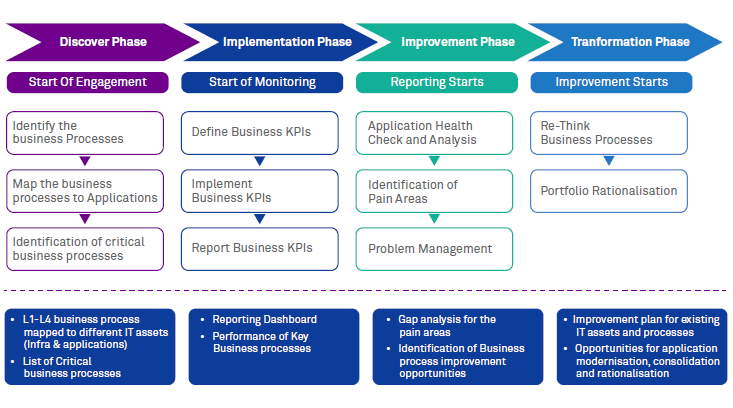
1. Discovery Phase
Objective of this phase is to identify the business processes and map them to the different assets/applications in the IT landscape. • Identify the Business Processes: Identification of business processes involves analysis of all available documentation (e.g. Business overview documents, SMTD, Statement of Work (SoW), Runbooks, Business Requirement Documents (BRD), Functional Specification Documents (FSD), landscape diagrams, etc.) to list all business processes involved in the IT landscape. As the next step, each business process (L1) needs to be drilled down to the lowest level L4 (Activity) as captured below:
Process category (L1) Process group (L2) Process (L3) Activity (L4) Store operations (Process Category) Point of sale (Process Group) Billing (Process) e-payment (activity)
It is recommended to review the business process with architect/Business Analyst and seek approval from the customer. Output
-> List of business processes
->Details on process category, Process group, Process, Activities
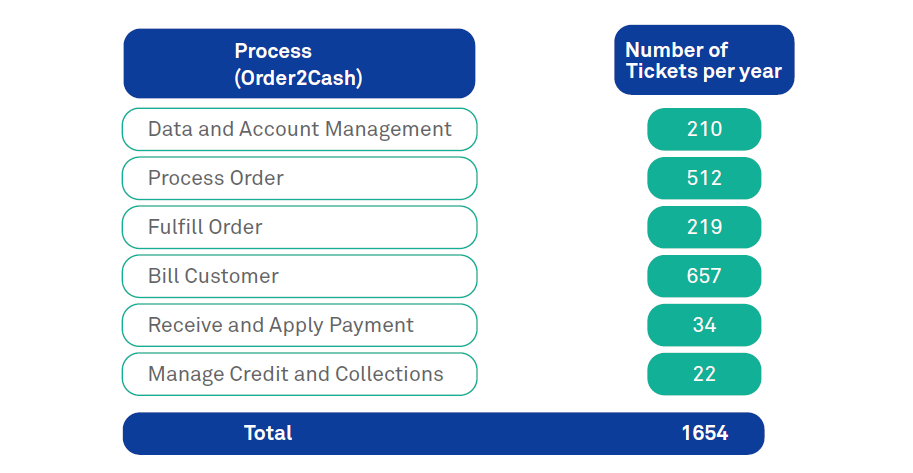
2. Implementation Phase In this phase, identify the business KPIs, develop KPI dashboards and initiate monitoring the performance of the identified critical business processes.
Define Business KPIs: Define the business KPIs corresponding to critical business processes (e.g. Delay in SO Creation, lead-time required to order, etc.) Also, identify the IT entities and associated IT KPI for each of the business KPI. This provides insight on which of the IT Entities are critical to achieve the Business KPIs and how to monitor the IT entities associated with Business KPIs. We need to identify the IT asset sources (examples Transactions, DB or program) linked with the business KPIs.
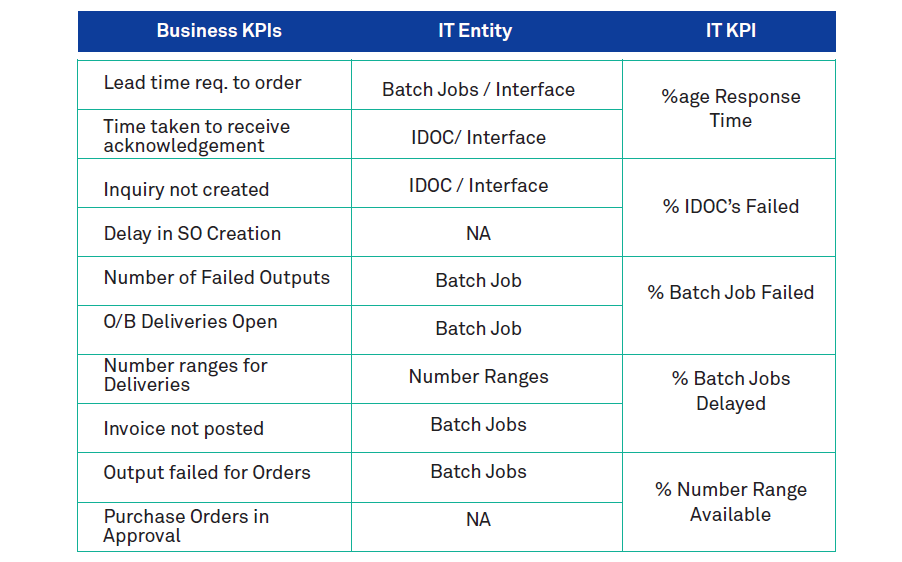
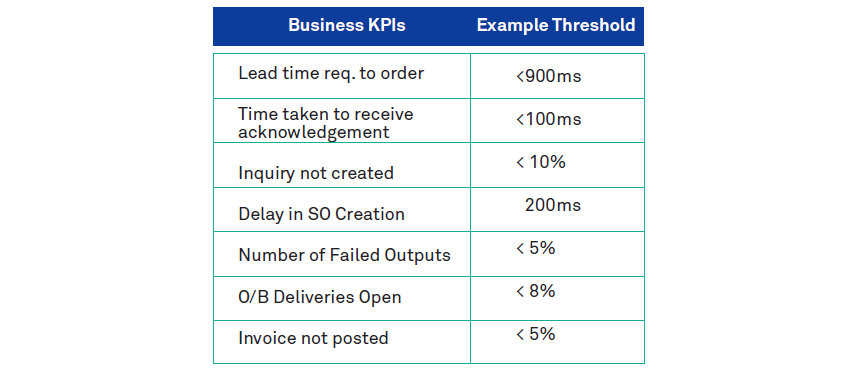
Implement Business KPIs: Several tools are available to configure and measure Business KPIs. Examples of these tools are AppDynamics, Dynatrace, SOLMAN, New Relic, and SolarWinds. Appropriate tool can be shortlisted based on the IT landscape, tool cost and other business considerations. Once the tool is shortlisted, it needs to be configured and integrated with IT asset sources to extract KPI measurements in real time. Also, dashboards and customized views should be defined as per business requirement.
Report Business KPIs: Tools have the capability to track and generate reports in real time, which can be made available for business users. Output:
->Signed off business KPI & thresholds
->Business KPI real-time measurement
->Reporting Dashboard
3. Improvement Phase
While addressing Business KPI performance, it is equally important to understand health of applications/Infra assets and identify improvement possibilities. In this phase, Business KPI performance is leveraged to identify the root cause and corrective & preventive measures. For example, ‘Lead time to order’ Business KPI can be tracked hourly and if the average time exceeds agreed threshold (900 milli seconds), an alert from the Business KPI tracking tool will be triggered to the respective support teams. This trigger will enable support teams to act in time, much before business user generates the ticket. To improve the Business KPI performance underlying health of the IT assets (application & Infra) should be analyzed in a three-pronged approach –Application Health check analysis, Technical debt & Duplicity analysis- and improvement opportunities should be leveraged.

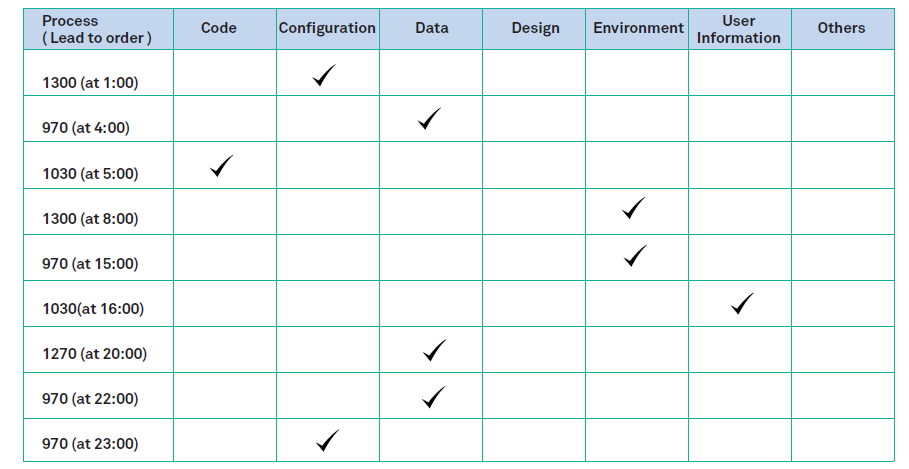
Technical Debt: Perform analysis of technical debt for the applications (implied cost of additional rework) There are tools (e.g. CAST, SonarQube) CAST application assessment provides scores on Efficiency, Robustness, Security and Maintainability parameters. Apart from performance, it provides details on security risk as well. Below is a snapshot of technical debt analysis output, score of less than 2.5 needs to be addressed as priority.
Duplicity Analysis: For different regions (say North America & Europe), same Business KPIs might involve different IT assets (different servers or different applications). Consolidation of functionality across regions to unified set of assets can improve business KPIs. Once we have the inputs from the above approaches, they are consolidated and pain areas are prioritized for resolution. The output of this step has to be further validated by the respective stakeholders. Output:
->Gap analysis for the pain areas
->Identification of Business process improvement opportunities
4. Transformation Phase
Detailed insights on root cause of pain areas, performance issues and duplicated applications provides us an opportunity to re-engineer the business value chain though a functional or Technical approach
Technical Re-Engineering- can include application modernization, Application portfolio rationalization, and Cloud migration. Rationalization of applications based on parameters like technology, cost and risk dimensions. The outcomes can give us a clear indication on what levers like retain, retire, modernize and standardize. We can also use this output to come up with a cloud movement strategy based on the levers like Re-host, Refactor, Re-platform and Replace. Functional Re Engineering- The objective is to identify the opportunities to make improvements in the process, which will ultimately result in smoother and faster operations and a stable system. This can include elimination of duplicated applications re-design business process flow etc.
Case In Point 1: Technical Re-engineering Customer had a highly de-centralized / duplicated application stack across 2048 branches, with very basic tech stack (COBOL, flat files). This led to very high TCO and changes unmanageable. This was rationalized into centralized instance with 108 deployment.
Case In Point 2: Functional Re-engineering Customer had 6 CRM systems and 100+ UDBA for their commercial customers, which were consolidated into one Simplified MS Dynamics CRM system using Wipro’s EasyU asset (IP). This provided single customer view across the branches/front office that significantly helped in cross/up-sell opportunities.
Summary
This paper presents a four-step methodology to achieve business outcome based IT support by focusing on business KPIs as opposed to traditional SLAs. This approach lays emphasis on business user experience and empowering the business users. It is recommended to leverage available tools to monitor business KPI performance in real time. Detailed analysis of current KPI performance enables identification of improvement areas to re-engineer IT assets leading to an optimized & efficient IT landscape.
References:
Ashoka has 18+ years of industry experience in multiple roles - Project Lead, Project Manager, Delivery Manager, Solution Architect, Delivery Excellence and Presales & Bid Management. In his current role as Senior Consultant Manager, he is entrusted with the responsibility of driving end-to-end MAS Integrated deals for Technology SBU. Ashoka has a Bachelor’s degree and is a certified Six Sigma Green belt professional.
Ravish Verma is a Pre-Sales Consultant in Modern Application Services (MAS) service line focusing on large AMS and transformation deals. Ravish is helping customers in their operational transformation journeys by bringing in the Wipro IPs, tools, accelerators and 3rd-party solutions. He has an engineering background with Master of Business Administration (MBA) from Symbiosis Institute of Business Management (SIBM), Pune.
Praveen has 18+ years of experience in the technology industry across Delivery, Marketing, Sales & Presales roles. In his current role as Practice head, he is focusing on developing transformative solutions for Technology industry customers. Praveen has an engineering background with a Master of Science from BITS Pilani and MBA from IIM Bangalore.